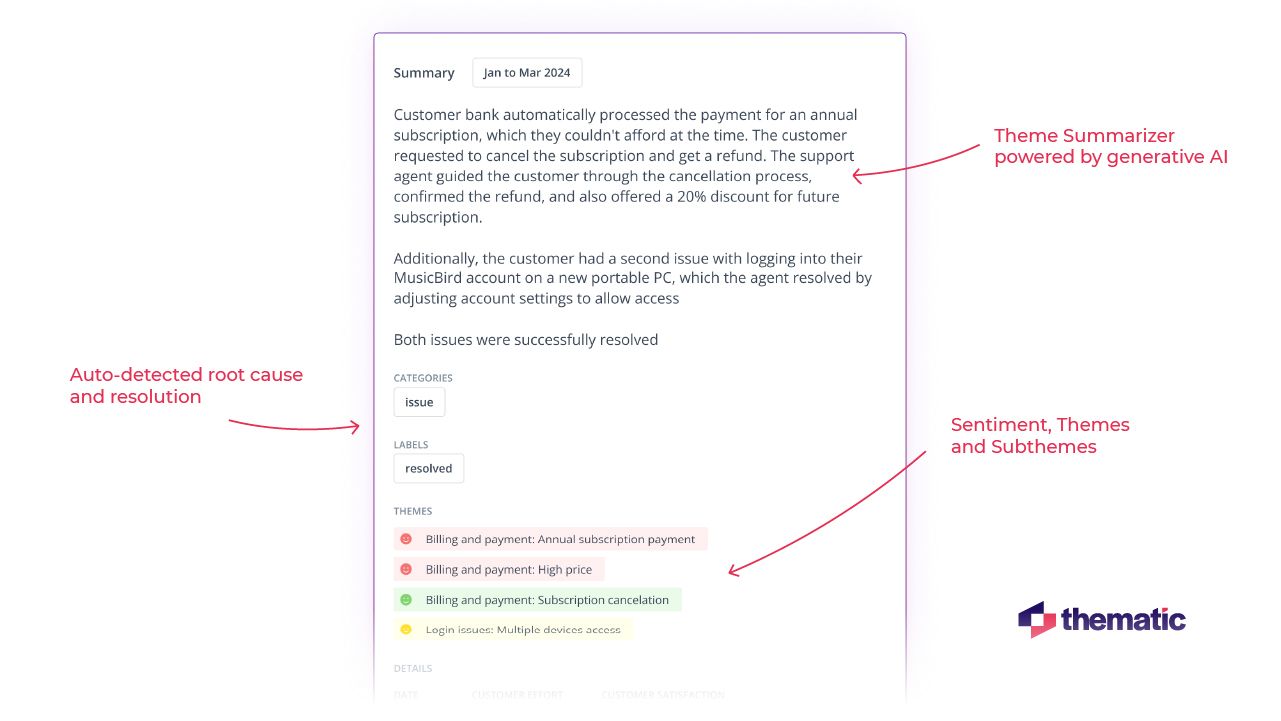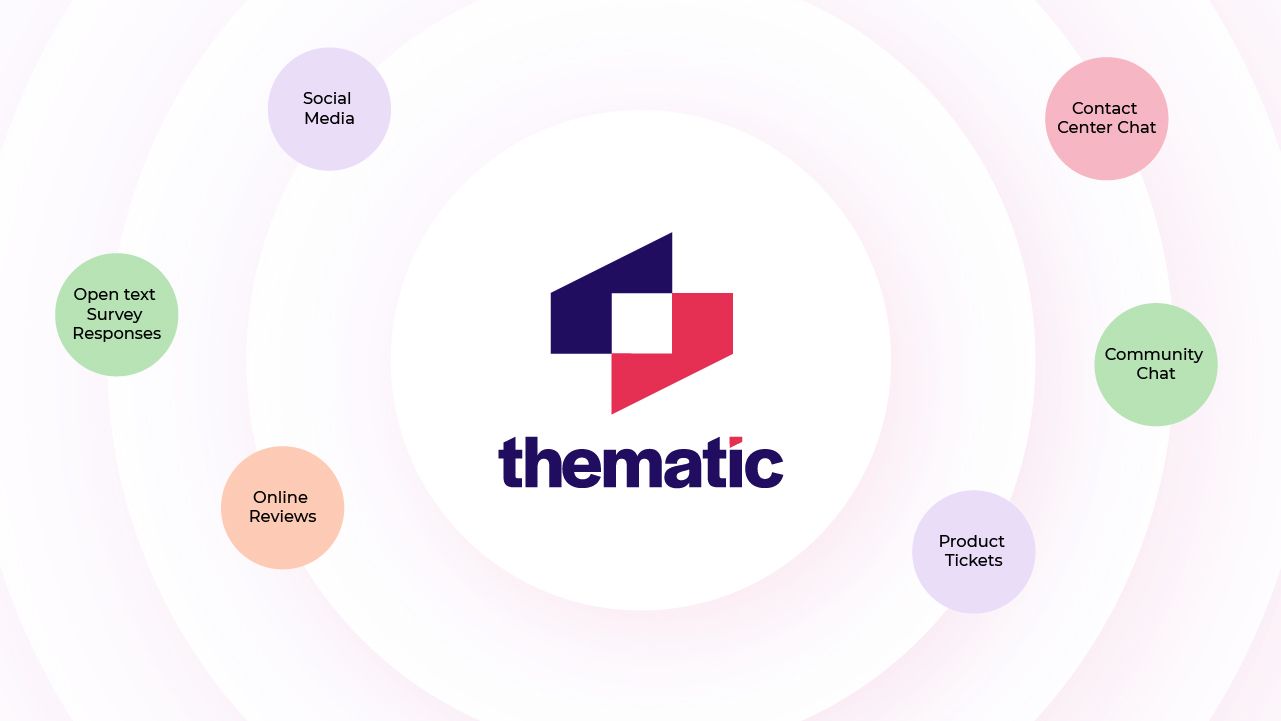
Companies that really understand their customers and respond to their needs build stronger relationships, boost loyalty, and achieve more success But how can businesses use data to consistently understand their customers so well?

These days, giving customers a great experience (CX) isn’t just a bonus—it’s a must. Companies that really understand their customers and respond to their needs build stronger relationships, boost loyalty, and achieve more success But how can businesses consistently understand their customers so well? The answer lies in using thematic analysis to explore and interpret all available data.
Thematic analysis is a way to look at data and find patterns. It helps you see what your customers are really thinking and feeling. In this article, we’ll talk about how thematic analysis can improve CX, especially with advanced AI-powered tools like Thematic. We’ll guide you through the process and demonstrate the benefits of these tools.
Understanding what customers are saying is key to making CX better, and to do this effectively, you need to analyze qualitative data. Analyzing qualitative data to uncover themes and patterns from diverse user responses is crucial for gaining deeper insights. Thematic analysis helps turn complicated feedback into clear, useful insights. By spotting patterns and themes, companies can fix recurring issues and show off what they’re doing well.
Why is thematic analysis so important for CX?
It helps you analyze qualitative data to identify patterns in feedback and find common themes that show what’s working and what’s not. Think about being able to quickly see what makes your customers happy and what frustrates them. That’s what thematic analysis can do.
Grouping feedback into categories gives businesses a full view of customer experiences. For instance, do customers often mention long wait times or praise friendly service? These insights are key to understanding what makes customers satisfied or dissatisfied and where to focus improvements.

Handling a large amount of customer feedback can be tough. Data collection is foundational in this process, as it precedes the analysis stages and sets the stage for successful thematic analysis and customer experience analytics. To gain meaningful insights, it is essential to analyze qualitative data effectively.
That’s why using AI-powered tools is a game-changer. These tools simplify the analysis process and make the insights more accurate and detailed.
AI-powered software like Thematic can significantly speed up your analysis. These tools quickly handle large amounts of data, saving you time and effort, and making it easier to analyze qualitative data. However, analyzing qualitative data through thematic analysis presents challenges such as time consumption and the risk of superficial analysis, while also offering benefits like identifying patterns and themes within datasets. Plus, they keep learning and improving, which means the insights get better over time.
Thematic’s algorithms can sift through thousands of feedback entries, finding patterns that humans might miss. This speeds up the analysis and ensures higher accuracy and consistency.
Thematic offers advanced features to give you deeper insights and make your analysis more useful. One of the key features is the ability to analyze qualitative data with high precision. Reflexive thematic analysis is a flexible approach that allows researchers to dynamically modify codes as their understanding of the data evolves, contrasting it with the more structured ‘codebook thematic analysis.’ Real-time analysis keeps you updated with the latest feedback trends. Interactive dashboards make it easy to see the data and share findings with others.

Customizing themes helps you focus on what matters most to your business. For instance, you might want to zero in on the onboarding phase or look at post-purchase feedback.
To truly understand your customers, it is essential to gather feedback from multiple sources. Once this feedback is collected, analyzing the qualitative data is crucial for extracting meaningful insights. Comprehensive feedback should come from various channels, including surveys, social media, customer support interactions, and product reviews. This approach ensures you get a complete picture of customer experiences.
Surveys: Send out surveys on your website, through emails, and in your app. These surveys collect structured data that is easy to analyze and gives you clear insights.
Social Media: Watch what people are saying on social media. The feedback here is often raw and real-time, giving you a direct look at customer feelings and trends.
Customer Support Interactions: Look at transcripts from customer support calls, chats, and emails. These can show you specific problems and what customers expect, giving you deeper insights.
Product Reviews: Collect and analyze product reviews from online platforms. Reviews give detailed feedback on product performance, usability, and satisfaction. They show what works well and what needs improvement.
When you analyze all the sources of the Voice of Customer in Thematic Analysis software, you get a full view of customer needs and experiences. This approach ensures you capture all important insights, providing a 360-degree understanding of your customers. By having more data, you can identify patterns and trends more accurately, leading to more precise and actionable insights. .Thematic integrates directly with over 35 popular sources of unstructured feedback, simplifying the process of gathering and analyzing data to gain meaningful insights.

After you’ve gathered feedback from different places, the next step is to analyze qualitative data to dig into the insights. Conducting qualitative data analysis can be complex and time-consuming. Choosing the right methods and tools is crucial to minimize human error and ensure the accuracy of the insights derived from the data. Thematic’s AI tools are great at finding common themes and patterns in your customer feedback, making the analysis process more efficient and reliable.
If you’re using a Thematic Analysis Software like Thematic to identify the recurring themes in your data, most of the work is done for you. Thematic sorts feedback into major categories like product quality, customer service, and usability by analyzing qualitative data. For example, if a lot of people talk about “slow response,” it goes under “service efficiency.” This helps you see the key issues that affect customer satisfaction.
Measuring these themes is crucial to knowing which issues to address first. To do this effectively, you need to analyze qualitative data thoroughly. Quantitative data plays a significant role in enhancing the analysis of customer feedback by transforming raw feedback into measurable insights.
Thematic’s platform shows how often each theme comes up and how important it is. This helps you focus on the most critical areas. Knowing how common an issue is helps you allocate resources more effectively to fix it.
Interactive dashboards clearly show these themes and trends, making it easy to understand the data and share findings with your team. By understanding these insights, you can make targeted improvements that lead to an enhanced customer experience.

Once you’ve found and measured your themes, it’s time to dig deeper. To gain meaningful insights, it is essential to analyze qualitative data effectively. Research data plays a crucial role in thematic analysis, as it helps extract meaningful insights and reveals deeper user motivations and experiences. Thematic has some really useful tools to help you understand more.
Thematic’s sentiment analysis looks at the emotional tone of the feedback. This process involves sorting comments into positive, negative, or neutral categories, allowing you to gauge overall customer sentiment. Using qualitative methods to understand customer emotions can provide deeper insights into the reasons behind these sentiments. . By thoroughly analyzing qualitative data, you can uncover underlying themes and patterns that explain why customers feel a certain way.
For instance, positive feedback like “friendly staff” indicates good service and can highlight strengths in your customer service team. On the other hand, negative comments such as “complicated navigation” point to areas needing improvement in your user interface. Understanding these emotions gives you valuable insights into what’s working well and what needs fixing.
Additionally, sentiment analysis can reveal trends over time, showing how customer perceptions evolve with changes in your product or service. This helps you proactively address issues and continuously enhance the customer experience. By leveraging these insights, you can make data-driven decisions that directly improve customer satisfaction and loyalty.
Finding the root causes of negative feedback is crucial. To do this effectively, you need to analyze qualitative data in detail. Thematic identifies main problems like “complicated navigation” or “missing features." This helps you focus on the right fixes.
Tracking feedback trends over time helps you anticipate and address emerging customer needs. To effectively identify these trends, you must consistently analyze qualitative data. For example, if you notice a growing number of complaints about "mobile app issues," it signals a need to enhance your app. By staying on top of these trends, you can proactively make improvements, ensuring that your product evolves with customer expectations over time.
Trend analysis lets you anticipate changes in customer expectations and address issues before they grow. By staying ahead of trends, you can keep improving your customer experience and stay competitive.

To improve customer experience (CX), turning insights into action is crucial. These insights are derived from the ability to analyze qualitative data effectively.
By comparing thematic analysis with other qualitative analysis methods used in fields like social sciences, psychology, and market research, you can gain a broader perspective on data interpretation. This broader perspective helps you understand different approaches and choose the best methods for your specific needs. Understanding these varied methods allows you to figure out priorities more accurately, make detailed plans, and implement effective changes. This process ensures that the actions you take are well-informed and tailored to improve customer experience.
Using a Thematic Analysis software like Thematic to see which themes have the biggest impact on CX. For example, if feedback shows that “ease of use” is a big issue, start by improving usability.
Incorporate the Kano Model to prioritize improvements based on customer satisfaction and delight. Additionally, drill down into sub-themes to understand what specific aspects of the product or service are causing the 'ease of use' theme to appear frequently. Determine the sentiment associated with this theme as well, as it might be positive. For instance, positive comments about ease of use could highlight areas to further enhance, while negative feedback indicates critical areas for improvement.
By focusing on the most important themes, you make sure your efforts make the biggest difference. This way, you get the best results with the resources you have. You can also drill down into sub-themes to see what about the product or service is causing the “ease of use” theme to show up so often and what the sentiment of the theme is.
Create detailed plans to tackle high-priority issues. This might involve redesigning interfaces, enhancing training, or launching new features based on customer feedback.
A good action plan lists the steps needed to address each issue, assigns tasks, and sets deadlines. Mention calculating the ROI of CX to win stakeholders’ approval.
Well thought out plans make sure improvements are made in an organized and efficient way, addressing the root causes of customer dissatisfaction and boosting overall satisfaction.
Alright, let's talk about how to actually implement changes based on Thematic’s insights and make sure they match customer expectations and fix key issues. Here’s a step-by-step guide to get you started:

Improving customer experience (CX) is an ongoing process. To keep getting better, it is essential to continuously analyze qualitative data. Setting up a feedback loop helps you keep getting better.
Regularly gather feedback with Thematic. To make the most of this feedback, it is crucial to analyze qualitative data effectively.
This keeps your strategy fresh.
Collecting feedback often helps you understand your customers’ needs. It lets you spot problems early and fix them before they grow.
Check how your changes affect customer satisfaction and overall experience. This helps you adjust your approach. Use Thematic’s metrics to track the results of your actions. Find out what needs more attention.
Measuring the impact of changes gives you insights into what works and what doesn’t. This helps you make better decisions based on real data.
Use the feedback to keep improving. To make the most of this feedback, it is essential to analyze qualitative data consistently. For example, if new feedback reveals issues with a recent update, don't wait—fix them ASAP! This quick action shows customers that you're listening and responsive, keeping your CX strategy aligned with their needs.
Think of it as a cycle: gather feedback, analyze it, implement changes, and then gather more feedback to see how those changes work. By doing this, you keep your customer experience strategy fresh and relevant.
Refining your approach based on real-time feedback helps maintain high customer satisfaction and loyalty.

If you want to improve your customer experience (CX), thematic analysis can be a game-changer. By gathering and looking at feedback in a structured way, you can analyze qualitative data to find out what your customers really need and want. This helps you make meaningful improvements that matter.
Using AI tools like Thematic makes this process even better. These tools help you analyze data quickly and accurately, ensuring your CX strategy is based on real insights and focused on your customers.
Key Takeaways:
Ready to take your customer experience strategy to the next level? Start using Thematic’s AI-powered thematic analysis today and turn feedback into clear actions. See how Thematic works or get a free guided trial on your data today.
Join the newsletter to receive the latest updates in your inbox.